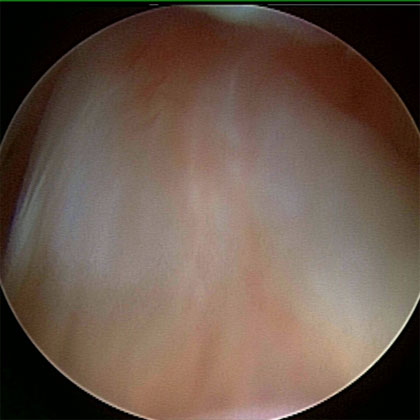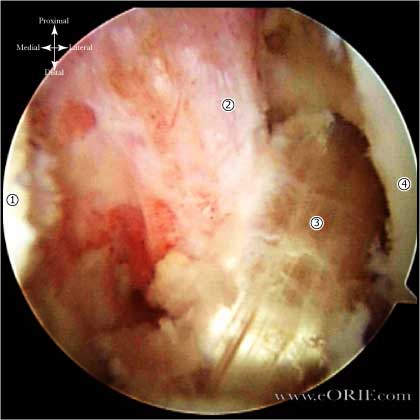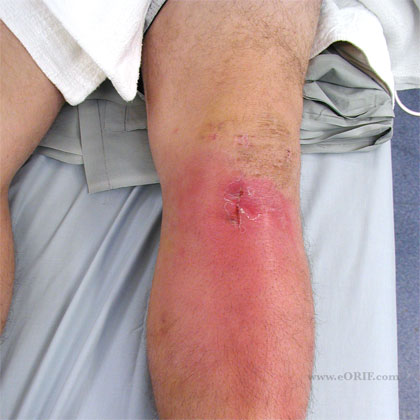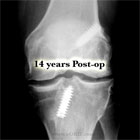|




|
synonyms: ACL repair, ACL reconstruction, anterior cruciate reconstruction
ACL Reconstruction CPT
ACL Reconstruction Indications
- Complete tear with MCL or LCL injury
- Complete tear, IKDC Level 1 or 2 activity
ACL Reconstruction Contraindications
- Partial tear with >50% of ACL intact and no functional instability
- Isolated complete tear in patient with IKDC Level 3 or 4 functional level
ACL Reconstruction Alternatives
- Non-operative treatment: physical therapy, ACL brace
ACL Reconstruction Pre-op Planning / Graft Considerations
- Graft options: Autograft patellar, hamstring, and quadriceps tendons. Allograft quadriceps, patellar, Achilles, hamstring, and anterior and posterior tibialis tendons.
- QT autograft has comparable clinical and functional outcomes and graft survival rate compared with BPTB and HT autografts. QT autograft has less harvest site pain compared with BPTB autograft and better functional outcome compared with HT autograft. (Mouarbes D, AJSM 2019). The Quad tendon with bone block will add 15 to 20 mm length to the graft, need to measure preop ACL length on MRI ( range 25 to 45 mm) . If the ACL length is > 35 mm consider adding the bone block.
- There is no difference in nonvalidated outcome measures including return to preinjury function, Tegner, Lysholm, Cincinnati or IKDC 1991 scores between BTB or hamstring reconstructions. (McCarty EC, OKU-8)
- BTB vs Hamstings(Gracilis,Semitendinosis) randomized studies show: 44% 0.5- 3.4 degree loss of ROM for BTB, 43% more stable by KT-1000 testing, 89% no difference in anterior knee pain, 100% kneeling pain.
- Hamstrings: 43% hamstring weakness
- BTB vs Hamstring outcomes: Graft failure(1.9% versus 4.9%); KT-1000 arthrometer side-to-side difference less than 3 mm(79% versus 73.8%); Rate of manipulation under anesthesia or lysis of adhesions (6.3% versus 3.3%); Anterior knee pain (17.4% versus 11.5%);Hardware removal (3.1% versus 5.5%). (Freedman KB, AJSM 2003;31:2).
- See (West RV, JAAOS 2005;13:197).
- Bone-to-bone healing of BTB autografts can occur within 6 weeks. Soft-tissue
grafts take 8 to 12 weeks (Rodeo SA, JBJS 1993;75A:1795).
- Delay surgery until patient has regained essentially full ROM, has normal gait and minimal effusion. Generally 2-6wks. Delay indicated to decrease risk of arthrofibrosis.
- Graft excursion <2.5mm from full flexion to full extension. (Fineberg Arthroscopy 2000;16:715)
- Tunnel position is the most common cause for technical failure. (Battaglia TC, Arthroscopy. 2005 Jun;21(6):767)
- Femoral Tunnel: should be as far posterior as possible preserving a 1-2mm cortical rim posteriorly. Center of 10mm tunnel should be 6-7mm anterior to posterior cortical rim of the intercondylar notch. 11 o’clock position for right knee. 1 o’clock position for left knee.
- Tibial Tunnel: Center should be along a line from the (1)posterior edge of anterior horn of the lateral meniscus, (2)just breach the lateral portion of the medial tibial spine, (3)7mm anterior to PCL(which gives 1-2mm wall after 10mm tunnel is reamed), (4)posterior aspect of tibial stump footprint. (Jackson DW Arthroscopy 1994;10:124-131). Vertical tunnels cause decreased flexion.
- Transtibial femoral tunnel preparation has higher odds of undergoing repeat ipsilateral knee surgery relative to anteromedial portal femoral tunnel preparation (Duffee A, JBJS 2013;95:2035).
- For revision ACL reconstruction consider freeze-dried allograft bone dowels to fill bony defects. . (Battaglia TC, Arthroscopy. 2005 Jun;21(6):767)
ACL Bone-Patellar Tendon-Bone (BTB) Reconstruction Technique
- average length of patellar tendon is 45mm but can vary up to 20mm. (Kenna B Arthroscopy 1993;9:228-230)
- tibial tunnel length = tendon length + tibial bone plug length – intraarticular distance(usually 23-30mm) (Fineberg Arthroscopy 2000;16:715-724): Indirect method of measurement = add 7 degrees to the length of tendinous portion of the graft and use this number for the tibial guide angle (Miller MD, Arthroscopy 1996;12:124-126)
- Patellar tendon harvest
- graft should be 9-10mm wide or 1/3 of tendon width. Do not harvest >40% of the tendon width. ie tendon width should be >25mm.
- triangular tibial plug 9mmx20mm for femoral tunnel
- trapezoidal patellar plug 10mmx25mm for tibial tunnel
- measures tendon distally
- 230 oscillating sawblade start distally to avoid blood in field
- trim fat
- size 9-10mm
- drill .062 Kwire in tibial plug
- mark tendo-osseos junction
- set. Angle 10° > length of graft
- notchplasty
- avoid vertically placed graft
- 7mm anterior to PCL, posterior edge anterior horn LM, posterior to notch in extension
- Femoral tunnel
- 7mm over the top aimer
- retrograde via tibial tunnel
- gives 2mm posterior wall
- ream to 35mm depth for 25mm graft
- ellipiticises anterolatcially to ease graft placement
- secure bone plug in hyperflexion
- Femoral interfence screw should be anterior to graft. Ensure interference screw is not divergent. A divergence angle >30° from the bone block results in lower failure loads. (Lemos MJ, Arthroscopy 1995;11:37).
- Graft patellar defects
- usually has 180° twist in graft after screw placement
- WB in extension for 6wks to protect donor sight
- 95% patient satisfaction
- 12% patellar pain
- 1-3% reoperation
- can fluoro check screw\tunnel
ACL Hamstring Reconstruction Technique
- Pre-operative antibiotics, +/- regional block
- Supine postion, all bony prominences well padded.
- Anesthesia (GETA / regional)
- Examination under anesthesia.
- Tourniquet placed high on thigh.
- Perform Knee Arthroscopy.
- Hamstring Harvest
- Sartorius, sartorius fascia=superficial and proximal
- Gracilis=rounder, palpable, proximal. Proximal attachment is circumferential, i.e. after harvest you should note muscle fibers coming off both sides of tendon. If only on one side you may have harvested semitendinosis.
- Semitendinosis-flat, larger, broader insertion, difficult to palpate. Muscle fibers only come off one side of tendon proximally.
- 3-4cm incision 3 fingers breadths below medial joint line, midline tibial shaft between crests
- Dissection to sartorius fascia, incise fascia just above Gracilis.
- Isolate gracilis, free fascial slips and excise with tendon stripper.
- Right angle clamp to pull semitendinosis into view, isolate, free fascial slips and excise with tendon stripper
- Deeper structure surrounded by fat is saphenous vein and nerve
- Cut grafts to 24cm and prepare on back table with #2 Ethibond whip stitches in each end.
- Debride ACL stump
- Notchplasty
- Tibial tunnel;just lateral to medial tibial spine, 7mm anterior to PCL in posterior half of ACL footprint, along posterior edge of anterior horn of lateral meniscus. Tunnel angled @45 degrees drill/dilate to size
- 3-4mm offset femoral tunnel guide used to place guide wire in the 11o’clock position for right knee. 1 o’clock=left knee.
- Drill femoral tunnel to 35mm with acorn reamer. Offset <5mm.
- Drill endobutton tunnel with endobutton drill. Measure femoral tunnel length.
- Endobutton size = femoral tunnel length – 25mm. Usually 25-45mm.
- Place a line on the graft 6mm distal to the femoral tunnel length to indicate the point at which the graft is seated deep enough to flip the endobutton.
- Intrafix tibial fastener: make sutures 5” form tibial tunnel and knot corresponding limbs together. Loop sutures over Tie Tensioner. Cylce knee with 30 lbs of tension. Compress tendons with sheath trial. Insert sheath with derotation lab in 12 o’clock position. Insert screw
- Consider spiked washer and screw tibial fixation augmentation.
- Irrigate.
- SQ closed 2-0 vicryl inverted interrupted
- Skin closed 3-0 monocyl running SQ
- Steri-strips, mastasol, portal sites closed with steri-strips
- Zeroform, 4x4’s, ABD’s, sterile-webril, Ace bandage, cryo-cuff, knee immobilizer locked at 15 degrees.
ACL Reconstruction Post-operative Xrays
- A/P view: center of the tibial attachment should be just lateral to the exact center of the tibia.
- Tunnel View(a/p at 60 degrees of knee flexion): femoral attachment should be lateral to the midline of the intercondylar notch and in the upper 2/3 of the notch. (Lintner Am J Sports Med 1996;24:72).
- Lateral view: Center of graft should be 40% of the a/p length of the tibial plateau posterior to the anterior edge of the plateau. Femoral tunnel should be at least 60% posterior along Blumensaat's line. (Khalfayan Am J Sports Med 1996;24:335-341) (Fineberg Arthroscopy 2000;16:715-724)
- Full Extension Lateral View: anterior border of tibial tunnel should be posterior to, and parallel with Blumensaat’s line. (Lintner Am J Sports Med 1996;24:72). If anterior border is anterior to Blumensaat’s line impingement is occurring.
ACL Reconstruction Complications
- Loss of stability / Graft failure: @10% (more common in patients younger than 20)(Webster KE, Feller JA, Leigh WB, Richmond AK. Younger patients are at increased risk for graft rupture and contralateral injury after anterior cruciate ligament reconstruction. Am J Sports Med. 2014 Mar;42(3):641-7.)
- Anterior knee pain / kneeling pain: 17.4%/100% BTB, 11.5% Hamstring
- Stiffness: 6.3%
- Painful hardware: 6.3%
- Infection: <2% most common pathogen is coagulase-negative staph (Staphylococcus epidermidis), followed by S. aureus.
- Patellar fracture / patellar tendon rupture: <1% (BTB grafts)
- Arthritis: incidence after reconstruction is unkown
- Arthrofibrosis: rare
- Cyclops lesion: rare
- NVI (saphenous neuralgia): rare
- Complex Regional Pain Syndrome: rare
- Hemarthrosis
ACL Reconstruction Follow-up care
- Hinged knee brace locked at 15 degrees for 6 days
- WBAT with crutches, discontinue crutches when comfortable, usually @ 2 weeks
- 1wk post-op: brace opened to 15 degrees to unlimited flexion. Knee brace may be removed when non-weight bearing
- Physical therapy 2-3x/wk for 12 weeks. After 1wk may begin low-resistance stationalry bike out of brace, quad sets, straight leg raises, early hamstring resistance exercises, closed-chain exercises with elastic cord.
- Bracing discontinued when patients have excellent muscle control about knee, generally 6weeks.
- 6wks=stair-climbing
- Consider functional ACL brace (CTi brace; OSSUR) from 6 to 12 weeks and for cutting and pivoting sports for 2 years after surgery.
- 12wks=cleared for all activities except: running on hard surfaces, terminal knee extensions with resistance, and jumping/pivoting sports.
- 6months=may do running and terminal knee extensions
- 8months=if 90% of hamstring and quadriceps strength have been regained and patient has full unrestricted ROM they may return to full, unrestricted sport with functional knee brace.
- Persistent effusion and failure to regain full extension indicates graft impingement. (Howell JBJS Am 1993;75:1044-1055.)
- Comparison between early accelerated vs nonaccelerated rehabilitation programs demonstrate no differences in long-term results for function, reinjury, and successful return to play. (Beynnon BD, Am J Sports Med. 2011 Dec;39(12):2536-48).
- Consider Home-based rehab (Howell, SM):
-Begin towel extension exercises immediately.
-Weeks 2-4: walk, swim, bike with high seat, no resistance. Should be able to extend and flex knee fully be 4 weeks, will have mild thigh atrophy and mild swelling.
-Weeks 4-8: May use all weight machines with low weight and 20 reps. By 8weeks should have full ROM with little/no swelling.
-Weeks 8-16: Begin running. If running straight without difficulty at 12 weeks begin agility exercises and jumping. By 16 weeks if knee is stable and pt can run and jump without difficult gradual return to full activities is allowed.
- Driving: may drive after 6 weeks for right leg; 2 weeks for left leg. (Nguyen T, Knee Surg Traumatol Arthrosc. 2000;8:226).
- Return to sport UPMC guidelines.
- see also Grant JA, JAAOS 2005 33:1288.
- ACL Rehab Protocol.
ACL Reconstruction Outcomes
- @90% restoration of knee stability, patient satisfaction, return to full activity. (Freedman KB, AJSM 2003;31:2).
- 20% of NFL players never return to play after ACL reconstruction. (Carey JL, AJSM 2006;34:1911).
- ACL reconstruction decreases the risk of future meniscal tear, improves stability, but its effects on delaying or preventing arthritis are unknown.
- ACL reconstruction is both less costly and more effective than nonoperative treatment for ACL injury. (Mather RC, JBJS 2013;95A:1751)
- at 11.5 year follow up: 7.0% graft failure for BPTB and HT autograft; Kellgren-Lawrence grade ≥2 arthritis found in 52.0% of BPTB and 51.0% HT autograft patients (Belk, JW, Arthroscopy https://doi.org/10.1016/j.arthro.2017.11.032)
- Knee Outcome measures.
ACL Reconstruction Review References
- Jackson DW editor, Master Techniques in Orthopedic Surgery: Reconstructive Knee Surgery 2nd Ed, 2002.
- Noyes FR, Barber-Westin SD. Anterior cruciate ligament graft placement recommendations and bone-patellar tendon-bone graft indications to restore knee stability. Instr Course Lect. 2011;60:499-521
- Driscoll MD, Isabell GP Jr, Conditt MA, Ismaily SK, Jupiter DC, Noble PC, Lowe WR. Comparison of 2 femoral tunnel locations in anatomic single-bundle anterior cruciate ligament reconstruction: a biomechanical study. Arthroscopy. 2012 Oct;28(10):1481-9. doi: 10.1016/j.arthro.2012.03.019
|




